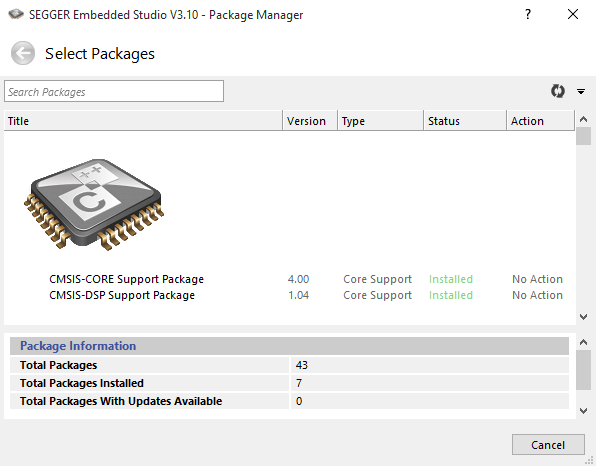

- #Open folder in segger embedded studio software#
- #Open folder in segger embedded studio code#
- #Open folder in segger embedded studio windows#
Any changes made to a perspective will be preserved the next time the perspective is opened. It is possible to manually switch between perspectives using the perspective buttons at the top right of the Workbench or by using the **Window → Perspective** menu. This perspective by default contains views associated with debugging.
#Open folder in segger embedded studio code#
When a debug session is started, Code Composer Studio will automatically switch to the **CCS Debug** perspective. For example, the **CCS Edit** perspective contains views most commonly used during code development, such as the Project Explorer, Editor and Problems view. Each perspective provides a set of functionality aimed at accomplishing a specific type of task. Only one workspace is active at a time in Code Composer Studio but you can switch workspaces using the **File → Switch Workspace.** menu.Ī perspective defines the layout of views, menus and toolbars in the Workbench window. You would check your projects into source control and each user would have their own workspace that references the projects. You would not check your workspace into source control to share with other team members. Workspaces are user specific and are not typically shared between users. The workspace folder is also used to store user information such as user interface preferences and settings. It is possible to specify to use the selected folder as the default folder to avoid being prompted in the future Once a project has been added to the workspace, it will be visible in the **Project Explorer** view.Ĭode Composer Studio will prompt for the workspace folder location when you launch the application. The default location of new projects will be within the workspace folder. The workspace stores references to all projects even if the projects themselves do not physically reside inside the workspace folder. The workspace is the main working folder for Code Composer Studio. If a project is opened from one Workbench, that same project will be present in all the Workbench windows.
#Open folder in segger embedded studio windows#
While each Workbench window can differ visually (arrangement of views, toolbars and such), all windows refer to the same workspace and the same running instance of Code Composer Studio. Multiple Workbench windows can be opened using the **Window → New Window** menu. A Workbench window offers one or more (#perspective). After the workspace location is chosen, a single Workbench window is displayed. When the Workbench is launched, the first dialog prompts for location of (#workspace). The Workbench contains all the various views and resources used for development. The Workbench refers to the main user interface. Some of the more commonly referenced concepts are described below. Hence understanding some of the basic concepts of Eclipse will lead to a better understanding of Code Composer Studio.
#Open folder in segger embedded studio software#
Starting with version 4, Code Composer Studio is based on the Eclipse open source software framework. Older LaunchPads that use the eZ430 debug interface such as the G2ĭetails of the macOS releases, debug probes and devices supported is available () For more details on installation instructions as well as debug probe and device support please see this ()Ĭode Composer Studio device support on macOS is limited to microcontrollers (MSP, C2000, SimpleLink, Tiva and Hercules) and does not include processors (Sitara, DSP, KeyStone).Įach Code Composer Studio release is validated against a set of macOS releases. Please note that Code Composer Studio is a 64bit application on Linux and thus will not run on 32bit distributions.Ĭode Composer Studio will run on other distributions but those are the officially supported and tested distributions. | Recommended | 6GB | 3.5GB | 2.0GHz dual core | | Minimum | 2GB | 900MB | 1.5GHz single core | Code Composer Studio combines the advantages of the Eclipse software framework with advanced embedded debug capabilities from TI resulting in a compelling feature-rich development environment for embedded developers. Familiar tools and interfaces allow users to get started faster than ever before. The intuitive IDE provides a single user interface taking you through each step of the application development flow. It includes an optimizing C/C++ compiler, source code editor, project build environment, debugger, profiler, and many other features.

Code Composer Studio comprises a suite of tools used to develop and debug embedded applications. Code Composer Studio is an integrated development environment (IDE) that supports TI's Microcontroller and Embedded Processors portfolio. This chapter provides a summary of the Code Composer Studio (CCS) integrated development environment.


 0 kommentar(er)
0 kommentar(er)
